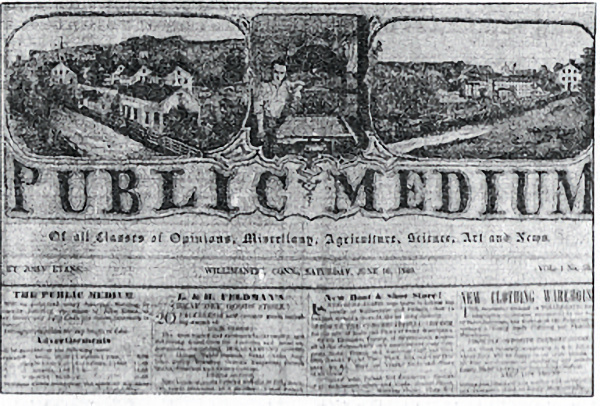by Tom Beardsley
3-30-2024

|
Willimantic's First Newspaper by Tom Beardsley 3-30-2024 |
(By Tom Beardsley) In 1848,
John Evans, a passionate advocate of the growing borough of Willimantic,
installed a printing press in Main Street's Franklin Hall and published
a weekly broadsheet. Only six issues of the Willimantic Public Medium
are known to survive. The most striking feature of
Willimantic’s first newspaper is its picturesque title. The
woodcut features a printer at his press. To the left is an early
scene of Main Street, looking northwesterly, featuring the old Baptist
church and wood-framed houses, with Prospect Hill in the background. To
the right is a southwesterly view from Main Street showing the rear of
the Smithville Cotton Mills.
Publisher John Evans was depicted weekly in a woodcut featured at the
head of the Medium‘s leading column. There were no street numbers in
Willimantic in 1848, so advertisers gave geographical
locations of their businesses.
William Weaver, a dealer in stationery, was in the Franklin book,
"a few rods east of the
congregational church." Traveling photographer Mr. W.R. Small, located
on the building’s third floor,
was preparing daguerreotypes for
Christmas. Small’s "perfect
likenesses" were produced in
Willimantic from $1 to $6, with
portrait lockets costing from $3
to $15. Dr. G. C. Vaughn’s:
“Vegetable Lithontriptic
Mixture" cured dropsy (retention of fluid), gravel (a urinary
dysfunction), fever, piles, and
purified the blood. Vaughn’s magic medication was manufactured in
Buffalo, N.Y., and cost $2 for a
30-ounce bottle, and $1 for a
12-ounce bottle. It was stocked
locally by pharmacists George Lathrop in Willimantic, D.M. Buel’s at
South Coventry, R. Button in
Andover, and A.H. Hawkins in
Tolland. Vaughn recommended that
one should stay away from
"Old Dr. Jacob Townsend’s
Sarsaparillas“ as they were "good
for nothingl" Dr.
Townsend’s ads claimed that
his sarsaparillas cured dyspepsia, rheumatism, pimples and
all female complaints. Vaughn denounced Townsend: “This
Townsend is no doctor and
never was; but was formerly a
worker on railroads and canals. Such willful, wicked misrepresentation."
Health matters were to the fore in 1849 because of a cholera
outbreak in New York City.
Between May 29 and June 5, the
city reported 129 cases and 50
deaths. A Dr. Bird of Chicago claimed that cholera could
be prevented by his magic formula, which consisted of four
parts powder charcoal and one
part sulfur. It supposedly neutralized the ozone, a chemical
in the atmosphere, which it
was thought caused cholera
when breathed in. In November
1849, the railroad arrived in Willimantic The first service was to New
London and back. Several cosmopolitan New Londoners, visiting
Willimantic for the first time,
were rather rude about rustic
Willimantic. They laughed at the
town’s tiny fire engine which
"doused miniature fires" and complained about the lack of sidewalks.
Publisher Evans agreed about the fire engine. Regarding the
sidewalks he added that the
New Londoners, "may thank
their stars they came in dry weather."
By 1855, the fancy woodcuts at the head of the leading page had
gone, and beneath the title it stated "An Independent, local, family
newspaper.“ This issue’s editorial noted the increasing prosperity of
Willimantic since the railroad had
come to town six years earlier. The local mills were fed by
cotton arriving ‘directly by train from the southern states’, and
local consumers had the benefit of sugar, molasses and salt
shipped to New London from the
West Indies and quickly brought
to Willimantic by rail. The paper
also announced the formation of the Bolton Reservoir and Water Power
Co. The leading shareholders
were the Windham and Smithville 'Manufacturing Companies on
Bridge Street, the Hop River Warp Co. in Columbia
and the recently formed Willimantic Linen Co. All aimed to
improve the water power on
the Willimantic and Hop rivers, to drive their mills more efficiently.
The Public Medium changed
its name to the Willimantic Journal the following year when William
Weaver, purchased it. He died in1866, and
W.J. Barber published the Journal until 1871. Henry Hall then
took the reins until 1886, The Hall and Bill Publishing Co. had taken
over in 1884, and continued
publication until 1911, when the weekly Journal was no longer able to
compete with the expanding Willimantic Daily Chronicle.
 |
| <<HOME>> <<back to Historical Articles index>> |